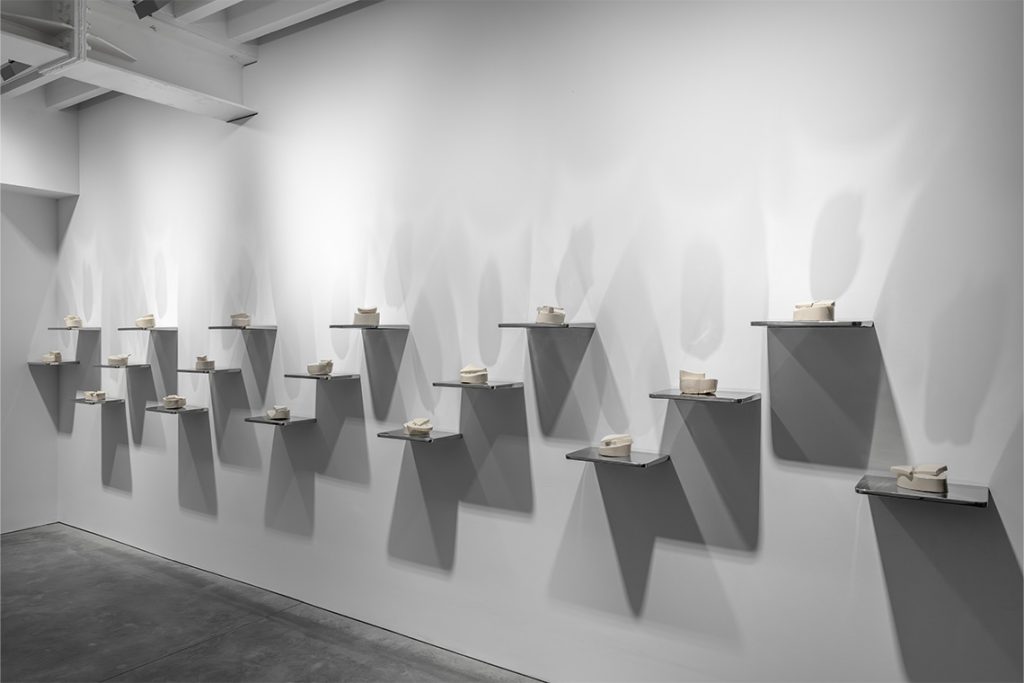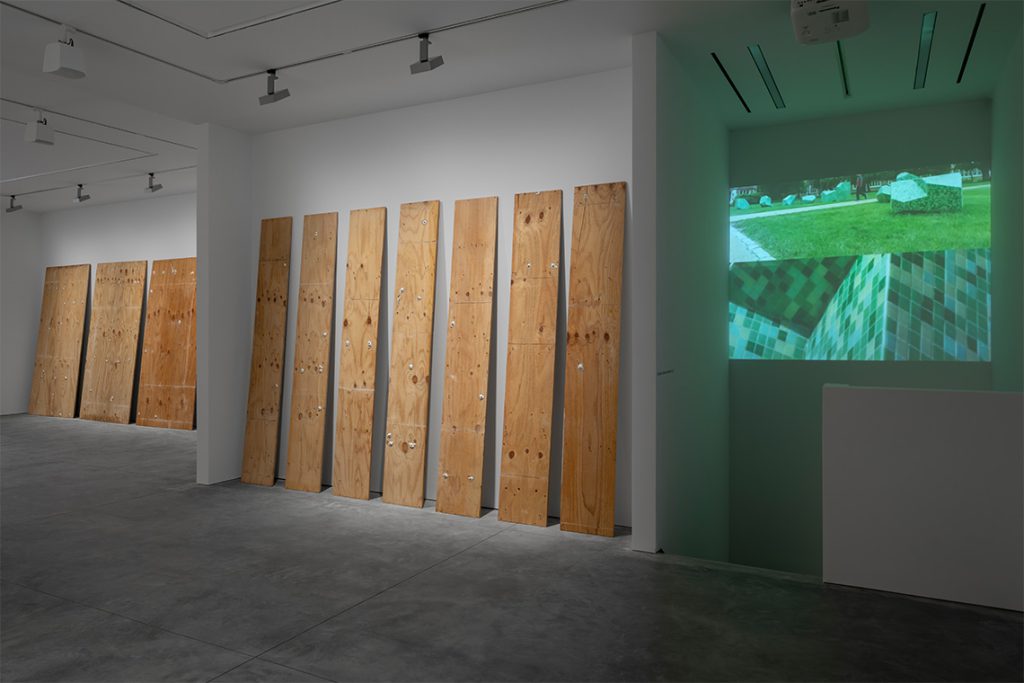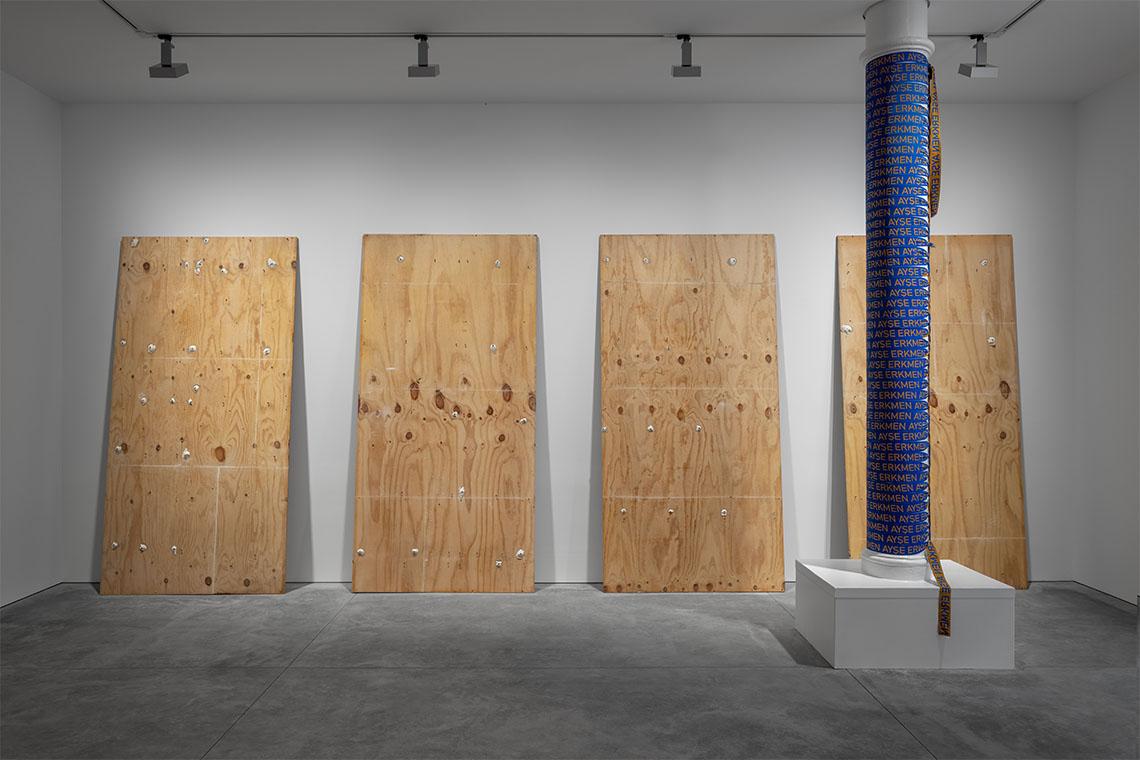The Istanbul-based gallery has opened a new space in the heart of London with an Ayşe Erkmen exhibition.
On the morning of Dirimart’s new London space opening last month, the gallery was a hive of activity. Books of the Turkish gallery’s artists were being unpacked and shelved, technicians were wiring up projectors and running checks, a man on a ladder was fiddling with the expensive new lighting, cables from countless machines snaked across the immaculately polished concrete floor and descended to a basement space in a similar state of last-minute energy. In the main spaces of the ground floor, well-worn timber panels embedded with nails and plasterboard remnants were leaning against the walls. The whole scene was a site of urgent construction.
Dirimart run two spaces in Istanbul – in the vibrant district of Pera, their main base since 2002, and a 2016 addition in the working-class district of Dolapdere. Later that evening their first international gallery opened successfully with an exhibition of seven new and recent works by Ayşe Erkmen. However, while all the cables were tidied away, projected videos now perfectly looping and smart finishes specified by New York architects StudioMDA now as perfect as in design renders, the rough, messy and damaged timber panels had been left leaning against the walls. Was this an error? Had the builders inadvertently left stock behind in their haste to finish and rush off site?

The 21 wooden sheets – titled I still insist, also the name of the show – had migrated from Dirimart’s Dolapdere space, the detritus of nails, marks and lumps of plaster evidence of unknown past exhibitions in which they were constructed elements of another gallery space, 2500 kilometres away. In relocating the material and then presenting what is usually hidden behind neat, white walls as sculptural forms demanding attention, Erkmen is making a layered statement. Not only is she giving visibility to ideas of concealed labour and value but she is also inviting questions around the process of what a gallery is, and what it means to suddenly open such a perfect, complete space within a context of its own history, politics and past. “Ayşe asks questions like ‘What happens when a gallery opens?’” Levent Özmen, director of Dirimart’s London gallery explains. “What does it mean for the artwork? What does it mean for the art professionals? What does it mean for the city itself?”
Özmen has programmed the first two years of the new space, but was always keen for Erkmen to be the opener, with her practice deeply interested in such institutional critique and conditions of construction. All the works in her new show were made this year, with the exception of Dolapdere (2017), a sound piece that quietly sinks into the architecture. It dates from Erkmen’s first show with Dirimart. In it, the artist recites the names of displaced or changed businesses in the Dolapdere streets surrounding their new space, an area that since the 2010 introduction of the Grimshaw Architects-designed Arter museum has been undergoing the globally recognised impact of gentrification. The names of the lost shops are mutated and deformed, a nod to the transmogrification of place that the introduction of such monied culture can result in. In a side room, a new film Dolapdere, the movie simply tracks the streets, shot from the side of a vehicle in perhaps an updating and relocating of Ed Ruscha’s celebrated study of LA’s Sunset Strip. It invites the viewer to wonder which of the small businesses captured in the tracking shot will not survive the ongoing economic and spatial shifts.
Located in the corner of Mayfair, tucked in between Regent Street and Oxford Street, it may be thought that Dirimart’s London gallery would not be an actor in art-adjacent gentrification. All places, however, are constantly undergoing subtle tectonic shifts. A short walk away, a Soho Italian deli that had been selling produce since 1961 was recently forced to close due to shifting economics. It has been replaced by an Italian chain cafe with branches from Dubai to Las Vegas that sells £15 sandwiches to a constant, snaking queue, formed following heavy and uncritical TikTok fluffing. The very streets and neighbourhoods surrounding Dirimart’s new gallery are similarly undergoing relentless and often quite aggressive development at the whim of capital, something of which Erkmen is not ignorant.

The value of such gentrification in London is now of such huge scale and high value that it is beyond the need of culture to offer a kickstart. Galleries and artists are now more likely to be the documenters and victims of such forces rather than agents of the process. It is perhaps this, with such a subtle gesture, that Ayşe Erkmen is drawing attention to with her works: that the pressures of Istanbul are not disconnected from those in London, and that while the immaculate Dirimart space carries the flawless aura of a white cube aesthetic, it is constructed of the same wooden sheets and plaster as homes, shops and communities the world over. Consequently, it is just as precarious within modern economic and political systems as everything else.
Having existed through two decades of ongoing Turkish turmoil, Dirimart understand very well what it means to survive in changing times. “2002 was just after a very dramatic economic crisis, it was like Türkiye changed overnight, it was shaky,” explains Özmen. He continues to list everything else the nation has faced this century, from the 2008 economic crisis, the art market boom following Istanbul’s 2010 turn as European City of Culture, the 2013 Gezi Park protests, the 2016 coup attempt, and more.
“The reason I’m telling you,” he offers, “is that it has been a bumpy ride. We found that we have to be eclectic in our choices of artist roster, it has to be cross-generational and cross-geographical in all directions.” In a delicate socio-political climate – not just in Türkiye but in most places, including their new home of England – and at a time when several commercial galleries are narrowing their offer or closing down completely, the path ahead may remain rough. But, with an approach that continues the awareness and nuance present in Erkmen’s first exhibition, and with a programme that seeks to be genuinely diverse, open and looking to bring together generations and worldviews rather than further divide, Dirimart London seems well placed to thrive.



